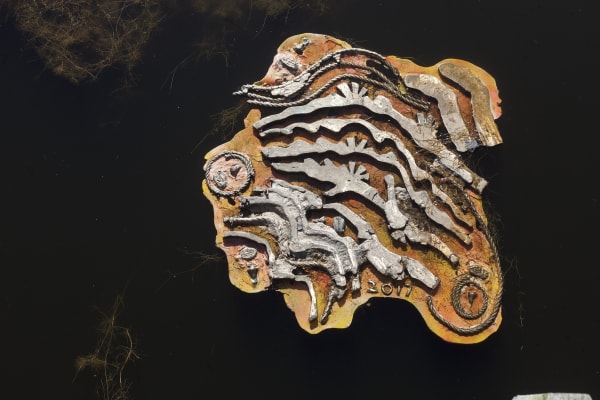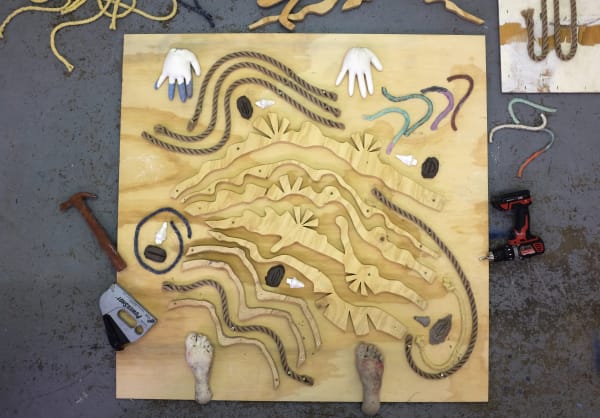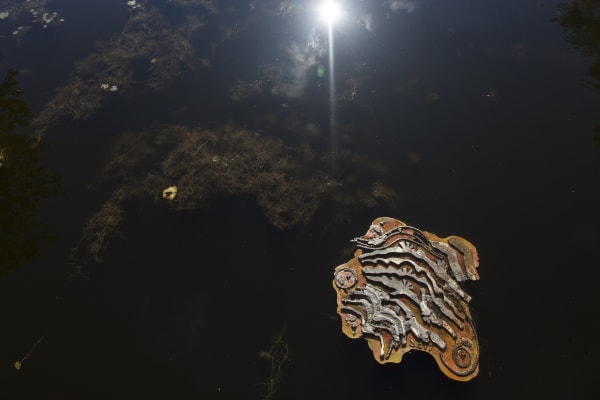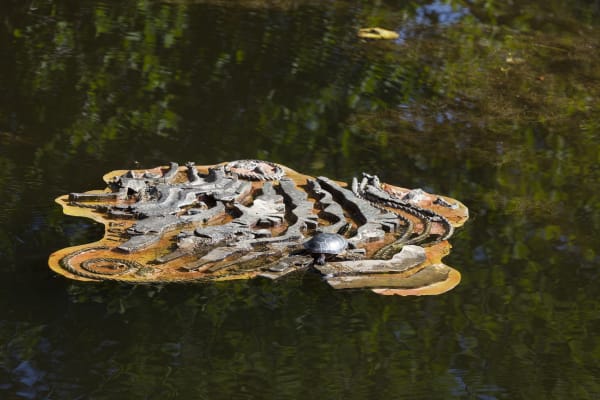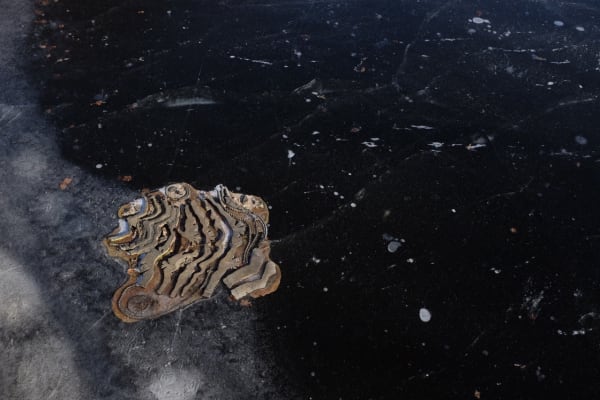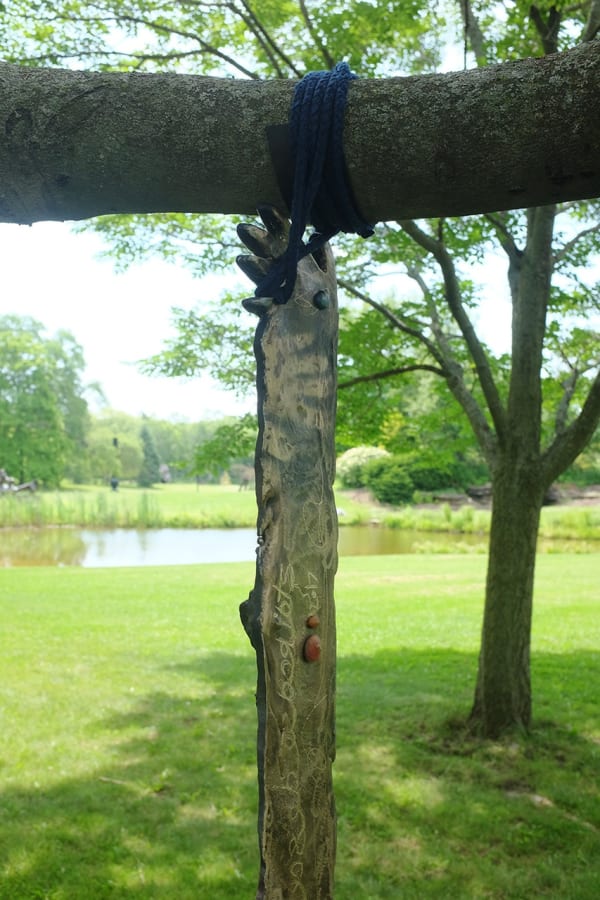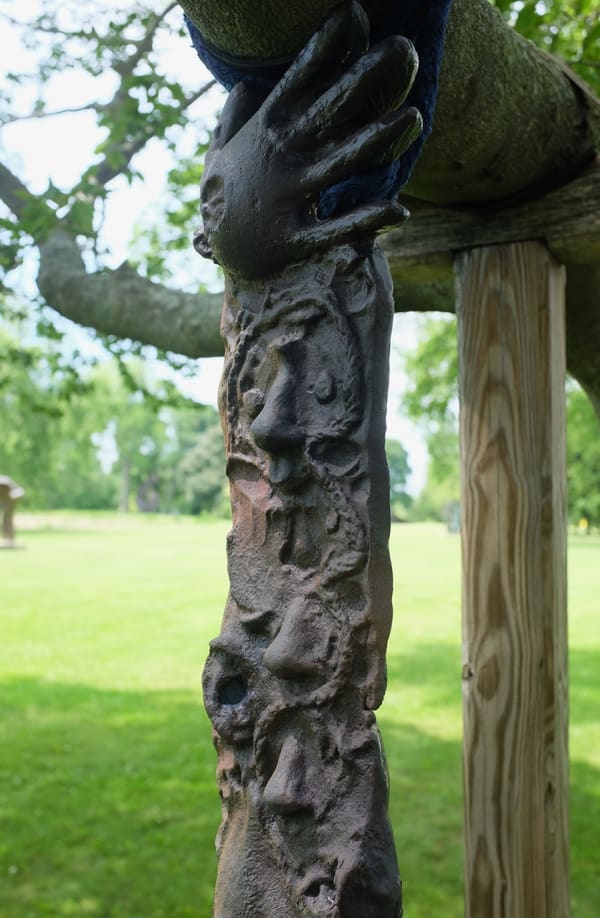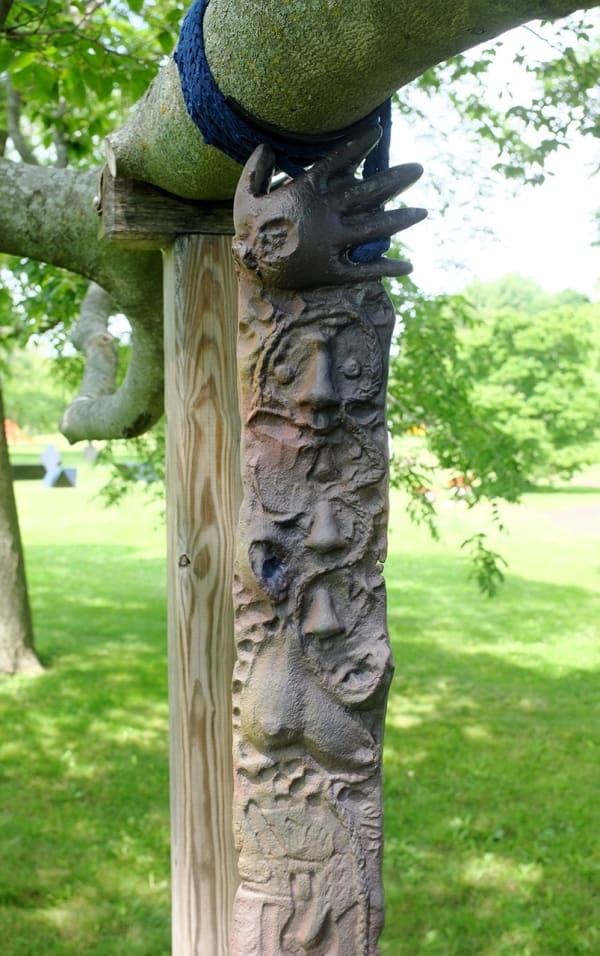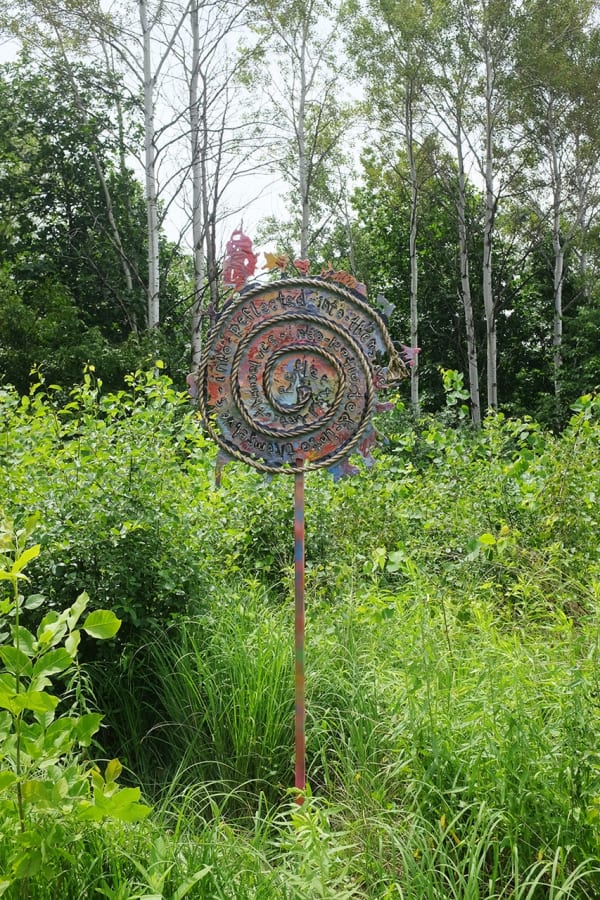Philip Martin: What are the origins of "Reflector?"
Katy Cowan: The sculpture "Reflector" came out of a larger exhibition at The Lynden Sculpture Garden in Milwaukee, WI in 2017. For this exhibition, I was given complete access to the interior traditional gallery space and the lush and expansive outdoor sculpture grounds. What was exciting and terrifying to me about this opportunity, was that I had never worked outdoors in a significant way. So, some questions I began with were: how could I create works in a meaningful way that could reside within such a lush and visually powerful landscape? How could I extend my practice in such a way that remained consistent with my conceptual concerns, while offering homage to the landscape I had grown up in and loved so much? How could I situate my outdoor pieces so that they interacted with both the viewer and the landscape in a compelling way? And what material could I use that would withstand years of outdoor exposure?
Like I said before, approaching how to make outdoor work was difficult, but "Reflector" was the piece that brought together the answers to these questions. The only thing I knew for sure about making outdoor pieces, was that I did not want them to be big, bright sculptures on concrete pedestals that would be situated 'nicely' on the grounds; this sort of sculptural interaction with the outdoors did not meet my conceptual intentions. Instead, I was trying to find a way that my sculptures could interact with the natural movements and life of the prairie while simultaneously drawing viewers to places on the Lynden grounds that may have been overlooked. So, I began my process for "Reflector" walking the grounds, observing the shifts in the landscape (both water and land), and making lots of sketches. And I found myself drawn to places that had little to no sculptures: I spent a lot of time in the overgrown prairies, hanging out on the bridges, sitting by the pond edges and resting under trees. I was drawn to these places because they showed signs of life, fluctuation, and were part of the natural landscape that Lynden resides in.
There is a bridge at Lynden that spans a pond connecting two parts of the park, and this is where I proposed "Reflector." When standing on the bridge and looking over the handrail, you are offered an incredible view into the active life of the pond (the frogs, turtles, fish, and birds) while also getting a perfect reflection of the passing clouds and surrounding willow trees on the water's edge. This is the sort of landscape and visual emotion I have felt the strongest towards throughout my entire life, and I wanted to have a sculpture enter that visual reflection. I thought that if I could make a piece to rest parallel on the water's surface, that the piece could become a part of the visual landscape rather than a piece that attempted to stand apart from the landscape. If successful, then viewers could look over the handrail and (hopefully) experience that same sort of paused viewing experience in the reflection of the entire life of the pond while also seeing my sculpture in its midst.
After establishing the placement for "Reflector," I had to then figure out what sort of material I could use to withstand years of being immersed in water. At first, I investigated making a large ceramic work, but I could not find a kiln large enough to fire the size I had in mind. After that, I thought about making a ton of small cast ceramic pieces that I could have floating in the water, but that did not satisfy my conceptual vision either. Then, I was asked by a fellow teacher at Milwaukee Institute of Art & Design (the school I was then teaching at) if I would like to learn how to cast and pour bronze - and this is when I first was introduced to metal.
PWM: Describe the process of casting "Reflector."
KC: Once I had determined the location and material for "Reflector," I then had to figure out the subject matter in order to make a mold to cast in bronze. For this exhibition, I was working with references to the Wisconsin prairie, the human body, and everyday objects. I selected these same sorts of references for "Reflector," but wanted to compose them with the site-specificity in mind. I wanted to show the rippling and fluctuating movement in water within my bronze form. To do this I worked to have the subject matter appear as if it were ebbing and flowing through one another - so breasts morph into cornflowers that morph into ropes that morph into tube socks that morph into noses and mouths. After I had decided on this composition, I reproduced the forms in hard foam, ropes and plasticine that I then made a sand-mold from. After the sand mold was created, it was prepped for the bronze pour.
When we casted "Reflector" my only goal in the bronze pour was to somewhat fill the sand mold I had created - enough so that the flowers, ropes and body parts would be recognizable. If the whole mold was not cast, that would have been fine with me. An advantage to working at this particular foundry was that I had a voice in how pours could result, and I became very interested in incomplete or mistaken pours. The reason for this is that these sorts of inconsistencies was where I found an interest in working with bronze. Where most foundries strive for perfect replication, that sort of result was of no interest to me. I became drawn to the active life of the metal when poured and dripped from the crucible - it did not seem like a material that should be so contained and perfected. So, when we poured "Reflector," I was open to any result that occurred during the process.
PWM: Tell me about the process of installing "Reflector" at Lynden.
KC: My proposed location for "Reflector" entailed important work with Lynden's installation team for it to be successful. Ideally, I wanted "Reflector" to be parallel with the pond's surface and in the middle of the viewing spot from the bridge; this desire prompted a couple engineering problems that the team helped me work through. First, we had to solve how it could rest parallel with the surface of water that fluctuated in depth throughout the seasons. And second, we needed to figure out how to move this 500-pound sculpture into the deepest section of the pond. The first problem was resolved by building a large, adjustable support system that could lower and raise the height of Reflector through a crank system (sort of like a camera tripod). The second obstacle involved renting an enormous fork-lift that could extend its reach to the middle of the pond.
While "Reflector" has the ability to be raised up and down, I have not yet asked Lynden to adjust its height. The advantage of having lived in the area for the year following its installation was that I was able to visit the piece in all the seasons. From visiting at these different times (and throughout the years), I discovered that the piece was fluctuating and adapting to its environment in ways I had not anticipated. Some summers it rests parallel to the surface, and some it hides a few inches below the water line. One winter it was perfectly parallel to the ice, and another it stood a few inches above. One summer the pond's frog population used it as a sun-pad. What I found from these long-term observations was that, rather than forcing it to remain at the constant I thought I had wanted, "Reflector" actually needed to be in fluctuation to fulfill my original concept.
PWM: You mention that "Reflector actually needed to be in fluctuation to fulfill my original concept" - what do you mean by that?
KC: When I was conceptualizing this show, I really wanted to draw attention to the fluctuations that occur in the physical and emotional landscape particular to Wisconsin. There is so much to take in yearly and so much drama - a sort of frenzy of summer, the calm of fall, the depression of winter, or the waking up of spring. And when this exhibition was opening in the peak of summer, I was thinking about the energy of human bodies, the vibrancy of life in the prairies and lakes, and the long days of activity that gently fold into evenings. Therefore, my guiding question was: How could I work with these sorts of fluctuations, and embody them in a sculpture that is seized in one, final position?
I tried to do this through placement, subject matter and material. By positioning this piece within rather than apart from the landscape, I was able to embed this sculpture within the fluctuating waterscape at Lynden. Further, by composing my subject matter in such a way that it appears to ebb and flow with the water it's interacting with, Reflector is not trying to stand apart from its surrounding environment. In terms of how I handled the material, the bronze appears to flow into the water which suggests its former liquid state rather than a perfected bronze form. Lastly, I chose to paint the piece with a light coating that I purposefully did not fix with varnish. As a result, over the years the paint has worn away and the natural patinas have changed the coloring of the bronze to show its age and adaptation to the pond it lives within.
Aside from the elements I had control over, there were others that I did not. As mentioned above, this sculpture has become a physical resting place in the summer for the turtles that live in the pond. Further, depending on the yearly rainfall, "Reflector" is either "on view" or is not - meaning, it will sit at the water line or it is engulfed by the raised water level from that year's rain. Or, it becomes an element embedded in the winter's freeze - stuck in position with the water frozen around it. For those things I had planned for with this piece, there are many that I had not. And those unplanned elements have become the most fascinating aspects for me to learn from and observe. This sort of long-term observation has opened up my ideas on how an artwork can fluctuate through time, seasons, and its original conceptions.

